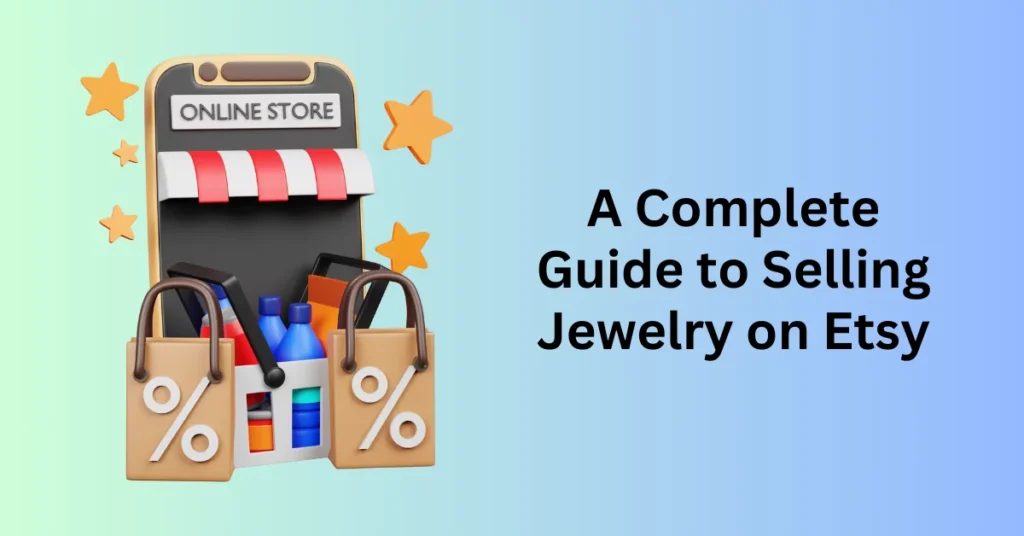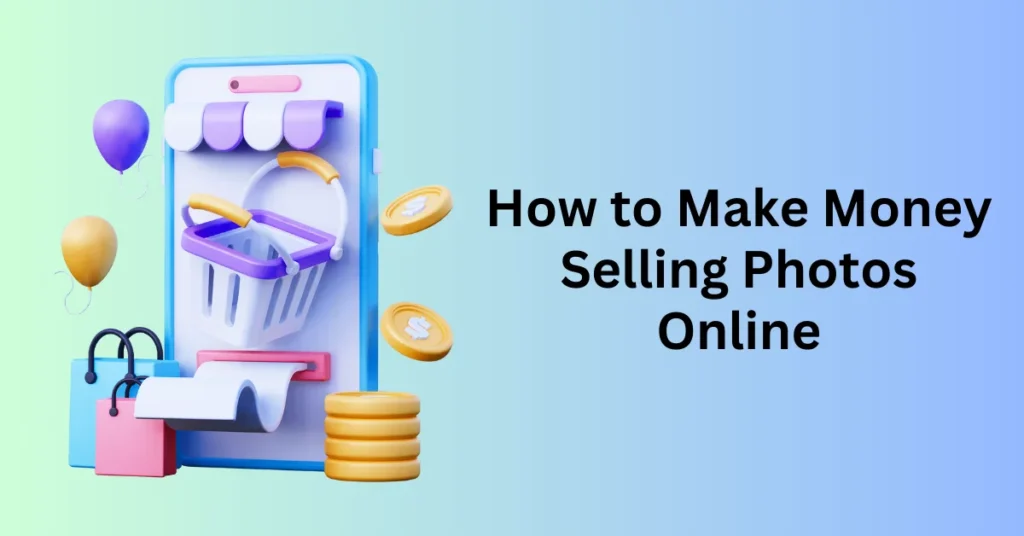Etsy stands as one of the top online shopping platforms, attracting over 445 million visits per month and boasting 96 million active buyers in search of handmade and unique items like jewelry. This expansive audience creates a prime opportunity for jewelry makers to grow their brand and connect with millions of potential customers seeking custom jewelry.
Whether you’re new to Etsy or have been selling for some time, this blog is packed with valuable tips and strategies to help you succeed. We’ll cover everything from conducting thorough market research to setting up your Etsy shop, implementing effective marketing techniques, and understanding Etsy’s fee structure.
Understanding the Jewelry Market on Etsy
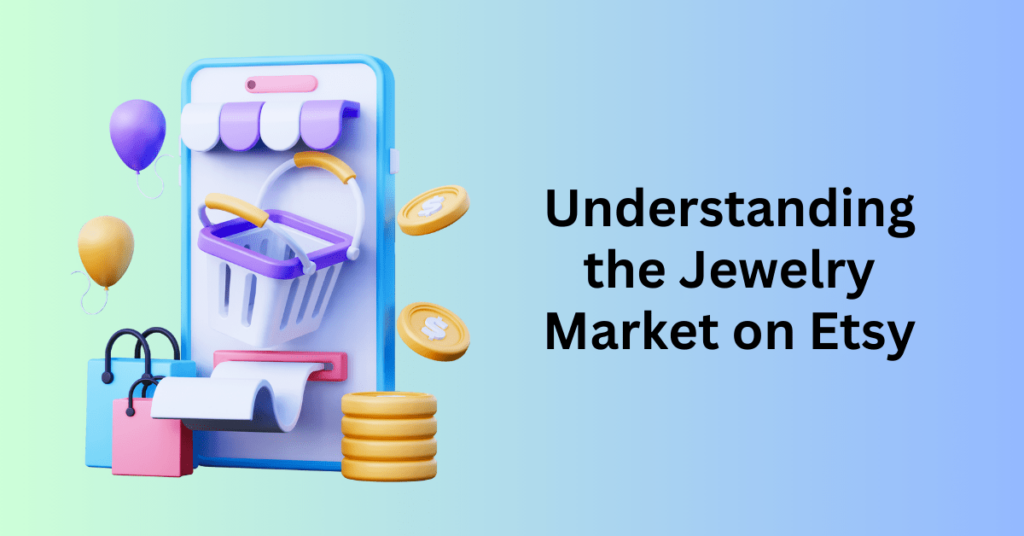
The jewelry market on Etsy is dynamic and multifaceted, offering a wide array of styles and designs to suit various tastes. Moreover, trends in this market shift rapidly, influenced by seasonal changes, evolving fashion preferences, and cultural moments. As an Etsy jewelry shop owner, therefore, staying ahead of these trends and understanding customer behaviour is crucial for crafting products that resonate with your audience.
To thrive in this competitive space, it is essential to engage in ongoing research and analysis of market trends. By leveraging popular platforms and tools, you can uncover valuable insights into what buyers are searching for and, in turn, create products that align with current demands. With that in mind, here are several ways to deepen your understanding of the Etsy jewelry market:
1. Leverage Social Media for Trend Insights
Social media is a treasure trove of inspiration and data, offering real-time insights into what’s popular in the jewelry world. Platforms like Instagram, TikTok, and Pinterest are particularly valuable for tracking trends and understanding buyer preferences.
- Explore Hashtags on Instagram: Search for trending hashtags such as #HandmadeJewelry, #MinimalistJewelry, or #BohoAccessories to discover the types of designs and styles that are gaining traction. Pay attention to posts with high engagement to identify popular aesthetics.
- Follow Popular Jewelry Accounts on TikTok: TikTok is a hotspot for showcasing unique jewelry designs and DIY trends. Follow influencers and creators in the jewelry niche to see which styles are captivating their audience. Look out for videos that go viral, as they often indicate emerging trends.
- Browse Popular Pins on Pinterest: Pinterest is an excellent platform for identifying visual trends in jewelry. Search for boards or pins related to jewelry styles, seasonal collections, or trending materials, such as resin, gemstones, or recycled metals.
2. Monitor Seasonal and Style Trends
Trends in the jewelry market often align with seasons, holidays, or significant events like weddings or festivals. To stay relevant, keep an eye on:
- Seasonal Shifts: Certain styles and materials become popular during specific times of the year. For example, pastel-coloured pieces often gain traction in spring, while metallic or gemstone designs are more prominent during the holiday season.
- Online Jewelry Publications: Regularly browse reputable jewelry blogs or magazines to get a sense of the broader industry trends. Publications like Jewelry Trends Journal or The Jewelry Editor often highlight up-and-coming styles and materials.
3. Use Analytics and Search Data
Leverage tools and reports that provide data on customer searches and buying behavior to refine your product offerings.
- Google Trends: Use Google Trends to identify what jewelry-related terms are frequently searched. Look for rising queries related to specific materials, designs, or categories like “custom jewelry” or “vintage-inspired pieces.”
- Etsy Trend Reports: Etsy itself often publishes trend reports, offering insights into popular categories, keywords, and styles on its platform. Use these reports to guide your product development and marketing strategies.
4. Engage Directly with Your Target Audience
Connecting with your potential customers is another powerful way to understand the market. Conduct surveys, read customer reviews, or interact directly with buyers through social media and Etsy messages. These interactions can provide firsthand insights into what customers value in jewelry, from design to materials to price points.
5. Stay Innovative
While tracking trends is vital, don’t be afraid to set your shop apart by introducing unique or innovative designs. Combining trend analysis with your creative vision can help your products stand out in a crowded market.
By consistently researching and adapting to the market, you’ll not only meet customer expectations but also position your Etsy jewelry shop as a go-to destination for fashionable and high-quality pieces.
How to Start Selling Jewelry on Etsy
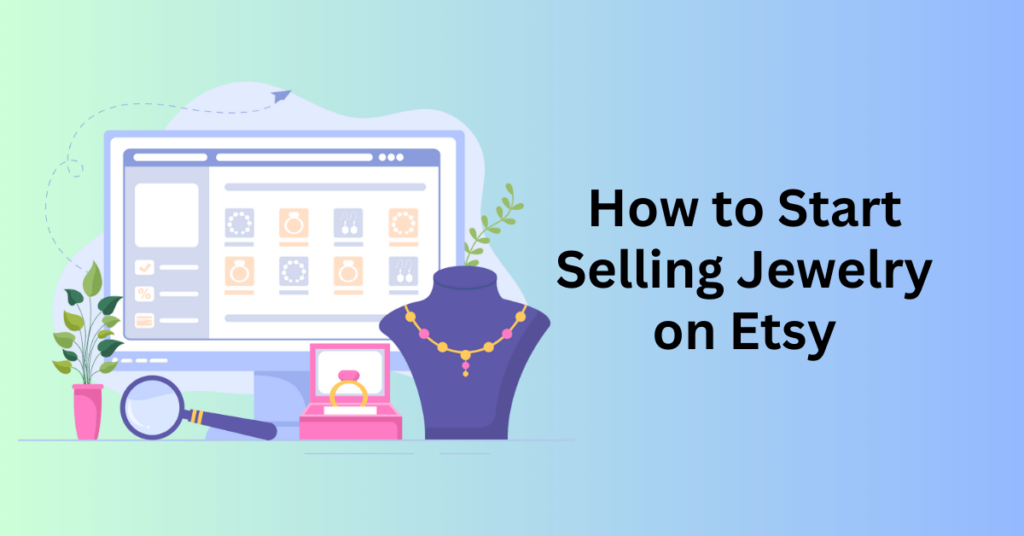
Selling jewelry on Etsy is an exciting and rewarding venture, especially for creative entrepreneurs. While Etsy provides a user-friendly platform, making your shop stand out requires a strategic approach. Here’s a step-by-step guide to help you start your jewelry business on Etsy and set yourself up for success.
1. Pick Your Niche to Start Selling Jewelry on Etsy
The foundation of a successful Etsy jewelry shop lies in selecting a profitable niche. Indeed, a well-defined niche enables you to target specific customer groups, build a loyal fan base, and focus your marketing efforts more effectively. By concentrating on a particular segment, you can create products that cater to the unique preferences and needs of your audience, ultimately increasing your chances of success.
To find the right niche, begin by researching the market. You can utilize tools like eRank or Google Analytics to identify trending jewelry categories, such as personalized pieces, gemstone jewelry, or minimalist designs. Additionally, as a quick tip, consider connecting your Etsy shop to eRank for detailed market insights and keyword suggestions, which can help you refine your approach.
Next, it’s essential to analyze the competition by examining top-performing Etsy shops within your niche. Study their products, pricing strategies, and branding to identify gaps or areas where you can differentiate yourself. By doing so, you will gain a clearer understanding of what works, which will, in turn, help you develop a unique selling proposition for your shop.
It’s also crucial to know your target audience. Whether you cater to brides seeking wedding jewelry, fashion enthusiasts in search of statement pieces, or eco-conscious buyers who prioritize sustainable materials, understanding who you’re selling to will help you create products that resonate with their specific needs.
Finally, validate your niche idea by using Etsy’s search bar to see what terms shoppers commonly use in your category. Examine the number of reviews and sales for similar products to gauge demand and ensure there’s sufficient interest in your offerings before committing to your niche.
2. Create a Branding Strategy to Start Selling Jewelry on Etsy
Your brand is the personality and story behind your Etsy shop, and it plays a crucial role in making your shop memorable while fostering an emotional connection with customers. A strong brand identity not only sets you apart from competitors but also helps to build trust and loyalty among your audience.
To build your brand, begin by defining your mission. First, decide what style or vibe your shop will convey—whether it’s minimalist, bohemian, luxury, or eco-friendly. Once you have a clear vision, write a mission statement that reflects the essence of your shop and resonates with your target audience. This will help them connect with your products on a deeper level and understand the story behind your brand.
Next, focus on choosing a colour scheme that aligns with your niche and the vibe you want to project. Tools like Canva or Adobe Color can assist you in selecting a palette that enhances your brand’s identity. For instance, pastel hues may work well for delicate, romantic jewelry, while bold colours are ideal for vibrant, statement pieces.
Then, shift your attention to designing a logo and creating a cohesive visual identity for your shop. Using tools like Adobe Express or Canva, you can craft a professional logo and ensure consistency across your product photography, social media, and Etsy banners. A unified visual identity will help reinforce your brand’s message and make your shop instantly recognizable.
Finally, develop a brand voice that aligns with your shop’s identity. Decide how you will communicate with your audience—whether your tone will be friendly and approachable or elegant and professional. Be sure to maintain consistency in your product descriptions, social media posts, and customer messages. This consistency will help create a cohesive experience that strengthens your brand’s presence across all platforms.
3. Choose Your Products and Fulfillment Method to Start Selling Jewelry on Etsy
Your product selection and fulfillment method are crucial for managing your shop effectively.
Options for Selling Jewelry:
- Handmade Jewelry: Craft unique, high-quality pieces yourself for a personalized touch. Handmade items allow for higher profit margins but require more time and effort.
- Print-on-Demand (POD): Use platforms like Printify to design and sell custom jewelry without upfront inventory costs. POD is ideal for scaling your business quickly while outsourcing production and shipping.
Fulfillment and Shipping Tips:
- Handmade Jewelry: Utilize Etsy’s shipping tools to streamline the order fulfillment process. Use the shipping calculator to estimate costs and offer competitive rates.
- POD Jewelry: Let Printify handle production and shipping. They provide transparent shipping rates, order tracking, and various shipping options, including express delivery.
- Create a Shipping Strategy: Offer free shipping to boost sales or clearly outline your shipping costs and policies. Display estimated delivery times and any potential fees, such as customs duties.
Quick Tip: Free shipping listings often rank higher on Etsy and are more attractive to buyers.
4. Optimize Your Etsy Shop to Start Selling Jewelry on Etsy
SEO is essential for driving traffic to your Etsy shop and improving visibility in search results. By optimizing your listings, you can attract the right buyers and enhance your shop’s discoverability. Consequently, implementing effective SEO strategies will help ensure that potential customers can easily find your jewelry, increasing the likelihood of a purchase.
To begin optimizing your store, start by researching relevant keywords. You can use tools like eRank or Marmalead to identify popular search terms within your niche. Once you’ve pinpointed these keywords, it’s important to incorporate them naturally into your product titles, descriptions, and tags. This step will boost your shop’s search rankings and attract more targeted traffic.
Next, focus on writing engaging product descriptions. Be sure to include all relevant details such as materials, dimensions, and care instructions. Additionally, emphasize what makes your jewelry unique and how it stands out from the competition. By naturally incorporating your keywords into the descriptions, you will also enhance your listings’ SEO and improve their visibility.
In addition to well-written descriptions, high-quality images play a crucial role in optimizing your shop. Showcase your jewelry with professional photos taken from multiple angles to highlight the product’s features. Furthermore, ensure that your photos have good lighting and clean, appealing backgrounds to make your products visually striking and stand out in search results.
Pricing is another key factor that influences your shop’s success. Therefore, take the time to compare your prices with similar items on Etsy to ensure they are competitive. You can use Etsy’s price calculator to strike a balance between profitability and affordability, helping you attract buyers while maintaining a reasonable margin.
Finally, remember to update your listings regularly. Refresh your keyword research and adjust your product descriptions to align with seasonal trends and evolving buyer preferences.
Setting Up Your Etsy Account and Store to Start Selling Jewelry
Starting an Etsy jewelry shop begins with creating a seller account and setting up your store. A well-structured shop will give your business the foundation it needs to attract customers and generate sales. Follow these steps to set up your Etsy account and storefront effectively:
1. Create an Etsy Seller Account
If you’re new to Etsy, you’ll first need to create a seller account.
Steps to Create Your Account:
- Visit Etsy’s homepage on a desktop browser.
- Click the Sell on Etsy button.
- Choose Sign in and create an account by providing your email address, name, and password.
- Follow the prompts to set up your seller profile and preferences.
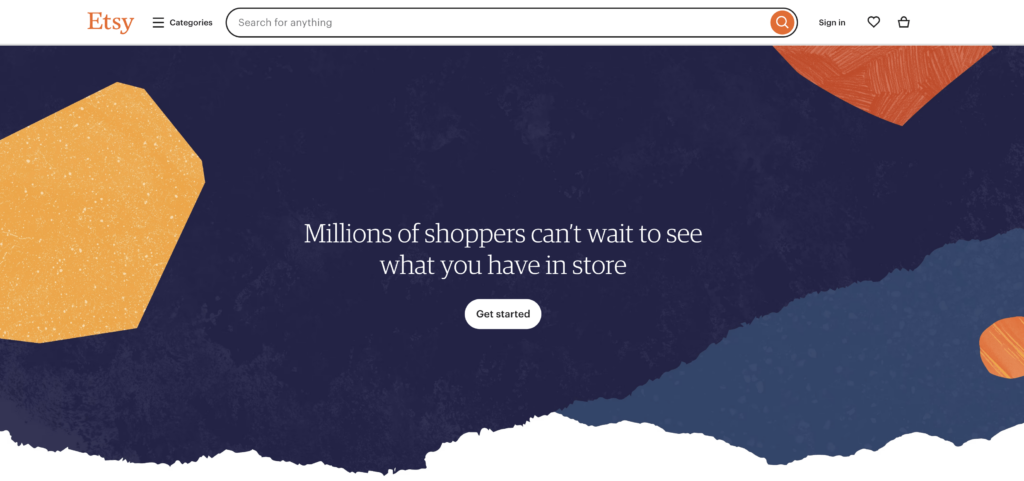
2. Choose a Catchy Shop Name and Set Preferences
Your Etsy shop name is one of the first things potential customers notice, making it a crucial part of your brand identity.
Tips for Choosing a Great Shop Name:
- Relate to Your Niche: Ensure your name reflects your jewelry style or niche. For example, “LuxeGem Designs” conveys a focus on luxury and gemstones.
- Keep It Memorable: Use a name that is easy to spell, pronounce, and remember.
- Check for Availability: Verify that your desired name isn’t already in use by another Etsy shop or on social media platforms. This ensures consistency and avoids confusion.
- Be Creative: Use descriptive words, puns, or alliteration to make your name stand out.
Set Up Your Shop Preferences:
- Select your shop’s default language, country, and currency.
- Choose whether you want to sell internationally or focus on local markets.
3. Set Up Payment and Billing
Etsy offers a seamless payment system that makes it easy for sellers to manage transactions.
Steps to Set Up Payments:
- Choose Etsy Payments: This built-in system supports a variety of payment methods, including credit cards, PayPal, Apple Pay, and Etsy gift cards.
- Consider Currency Conversion Fees: If you plan to sell internationally, be aware of potential fees for converting currency. These costs can affect your overall profit margin.
- Set Up Billing: Enter your credit or debit card details to cover Etsy’s seller fees. Etsy charges listing fees (currently $0.20 per item) and transaction fees (a percentage of the sale price).
Quick Tip: Familiarize yourself with Etsy’s fee structure to understand how it impacts your pricing strategy.
4. Create Your First Product Listing
To activate your shop, Etsy requires you to create at least one product listing. Don’t worry if you’re not fully ready—listings can be saved as drafts and updated later.
What You’ll Need for Your First Listing:
- High-Quality Product Images:
- Showcase your jewelry from multiple angles.
- Use natural lighting or professional equipment for sharp, clear photos.
- Highlight details like intricate designs, materials, or unique features.
- Detailed Product Descriptions:
- Include relevant keywords to improve search visibility (e.g., “handmade sterling silver earrings” or “minimalist gold necklace”).
- Mention materials, dimensions, customization options, and care instructions.
- Highlight your jewelry’s unique selling points (e.g., hypoallergenic materials, eco-friendly packaging).
- Set Competitive Prices:
- Factor in production costs, Etsy fees, and shipping expenses.
- Research competitors’ pricing in your niche to ensure your prices remain attractive to buyers.
Quick Tip: Use Etsy’s pricing calculator to determine an optimal price point that balances profitability with market competitiveness.
5. Finalize Your Store Setup
Once your account, preferences, payment methods, and first listing are ready, review everything to ensure your shop is complete and ready to attract buyers.
Next Steps:
- Personalize your shop with a banner and logo that align with your brand.
- Write an engaging shop description that introduces your business and tells your story.
- Create clear shop policies, including shipping timelines, return policies, and frequently asked questions.
With these steps, your Etsy store will be ready to launch and start attracting customers to your jewelry products.
Market Your Etsy Jewelry Store
Learning how to sell jewelry on Etsy requires a comprehensive marketing strategy to boost sales and visibility. Etsy provides a fantastic platform for handmade and unique creations, but standing out in a competitive marketplace demands focused effort. Below are key strategies to effectively market your Etsy jewelry store.
Social Media Marketing
Social media is a powerful tool for Etsy sellers to connect with their target audience and drive traffic to their store. By leveraging the right platforms and creating engaging content, you can significantly enhance your brand visibility and boost sales.
Instagram is ideal for sharing stunning photos, Reels, and Stories, while Facebook’s groups and pages help foster a community and share updates. TikTok’s short-form videos are perfect for highlighting your designs and creative process, and Pinterest allows you to create pins that link directly to your Etsy shop. To maximize your efforts, research where your target customers spend their time online and tailor your presence to those platforms.
Start by showcasing your jewelry with high-quality, well-lit photos and videos. You can also share behind-the-scenes snippets of your design process, packaging, or workspace to add a personal touch. Additionally, highlight customer testimonials by featuring reviews and photos from happy customers. To stay relevant, capitalize on seasonal and trend-based content by posting about new collections, holiday promotions, or the latest jewelry trends.
In addition, using hashtags and targeted ads can further expand your reach. Incorporate relevant hashtags like #HandmadeJewelry, #EtsyShop, or #BohoJewelry to increase visibility. Consider investing in social media ads on platforms like Facebook and Instagram to connect with users who are likely to be interested in your products. These platforms offer advanced ad targeting based on demographics, interests, and behaviors, ensuring your ads reach the right audience.
Finally, integrating social media with your Etsy store is an effective strategy. Use Etsy’s integrations with Instagram and Facebook to tag products in your posts and Stories. This allows customers to click directly through to your shop, making it easy for them to purchase your jewelry with just a few clicks.
Email Marketing
Email marketing is a highly effective strategy for building lasting relationships with customers and driving repeat sales. It is not only cost-effective but also provides a direct way to engage with customers through their inboxes, making it an invaluable tool for small businesses. Here’s how you can make the most of email marketing for your business.
To begin, start by building an email list. Offer incentives such as discounts, freebies, or exclusive content to encourage people to sign up. Additionally, use pop-up forms on your website or Etsy shop link pages to make subscribing both simple and accessible.
Once your list is built, focus on creating engaging email campaigns. Tools like GetResponse or Mailchimp can help you design professional, visually appealing emails. Use these emails to showcase new jewelry collections, promote limited-time sales, share exclusive offers, or provide behind-the-scenes content that resonates with your audience.
In addition, to make your campaigns more effective, segment your audience. Group your subscribers based on their preferences, purchase history, or geographic location. For example, you could send emails about matching necklaces to customers who have previously purchased earrings from your collection.
Finally, automate your emails to save time and maintain consistent communication. Set up a welcome series to greet new subscribers with an introduction to your brand and a discount code. You can also use abandoned cart reminders to encourage shoppers to complete their purchases and send post-purchase emails to thank customers, request reviews, or suggest complementary products. By automating these touches, you ensure that your customers feel valued and engaged at every step of their journey.
Influencer Marketing
Collaborating with influencers is a powerful way to showcase your jewelry to a wider audience and enhance your Etsy shop’s credibility. By leveraging the reach and influence of social media creators, you can not only drive brand awareness but also boost sales and grow your online presence.
To begin, define your goals for influencer marketing. By establishing clear objectives, you’ll be able to guide your strategy and measure success more effectively. Next, research creators within the fashion, jewelry, or handmade niches on platforms such as Instagram, TikTok, and YouTube. To streamline this process, consider using tools like BuzzSumo, Upfluence, or AspireIQ, which can help you find influencers with the right audience and engagement levels.
In addition, consider the type of influencer that best suits your campaign. Nano-influencers (1K-10K followers) are ideal for authentic engagement with niche audiences. On the other hand, micro-influencers (10K-100K followers) strike a balance between reach and high engagement. Meanwhile, macro-influencers (100K+ followers) offer extensive exposure, although they typically come at a higher cost.
When reaching out to influencers, it’s essential to collaborate effectively by providing clear proposals. Be sure to explain what you’re offering, such as free products, payments, or commissions, and outline your campaign goals. Additionally, share detailed timelines, content guidelines, and desired outcomes to ensure alignment and a smooth collaboration process.
Finally, don’t forget to track the performance of your campaign to assess its impact. Monitor key engagement metrics like likes, comments, shares, and mentions. You can also use unique discount codes or affiliate links to directly attribute sales to the campaign. By analyzing the return on investment (ROI)—comparing campaign costs with the sales and engagement generated—you’ll be in a better position to refine your strategy for future collaborations.
How Much Does It Cost to Sell Jewelry on Etsy?
Selling jewelry on Etsy can be a rewarding venture, but understanding the platform’s fee structure is crucial for maintaining profitability and effectively managing your shop’s finances. To price your jewelry competitively while ensuring you cover your costs, it’s important to account for the following fees:
1. Listing Fees
Etsy charges a listing fee of $0.20 per item, which applies to every product you list in your shop. Listings remain active for four months or until the item sells. If the item doesn’t sell within this timeframe, renewing the listing incurs another $0.20 fee.
2. Transaction Fees
When an item sells, Etsy charges a 6.5% transaction fee based on the sale price, which includes the cost of the item, shipping, and any gift-wrapping options chosen by the buyer. This percentage is deducted from the total payment you receive from the customer.
3. Payment Processing Fees
Payment processing fees vary by country but typically consist of:
- A percentage of the sale, usually between 3% and 4%.
- A flat fee based on the seller’s location (e.g., $0.25 USD per transaction for U.S.-based sellers).
For example, if you’re a U.S.-based seller and sell a necklace for $50, you might pay approximately $1.75 in payment processing fees (3.5% + $0.25).
4. Currency Conversion Fees
If your shop’s currency differs from the buyer’s currency, Etsy may apply a currency conversion fee, typically around 2.5% of the transaction total. To avoid unexpected charges, consider setting your shop currency to match your target audience’s most common currency or review Etsy’s official guidelines for updated details.
5. Optional Marketing and Advertising Fees
While not mandatory, Etsy offers optional paid services to help boost visibility for your shop, such as:
- Etsy Ads: Costs are based on your daily budget and bidding structure.
- Offsite Ads: Etsy charges 12% to 15% of the sale price if a customer purchases your product through an external ad Etsy ran on platforms like Google or Facebook.
Example Cost Breakdown
Let’s break down an example of selling a bracelet priced at $50 in the U.S.:
- Listing Fee: $0.20
- Transaction Fee: 6.5% of $50 = $3.25
- Payment Processing Fee: 3% of $50 + $0.25 = $1.75
- Total Fees: $5.20
From a $50 sale, you would net approximately $44.80 after fees, excluding shipping and material costs.
Final Thoughts:
Etsy provides a fantastic opportunity for jewelry makers, whether you’re crafting unique, handmade pieces or utilizing Print on Demand services. With its large, dedicated audience of buyers actively searching for one-of-a-kind products, Etsy offers a thriving marketplace for both new and established jewelry sellers. However, to succeed on Etsy, it’s essential to approach your shop with a clear and strategic plan.
First and foremost, understanding the market is key. To do so, conduct thorough research on current jewelry trends, customer preferences, and your competition. This will allow you to identify your niche and create products that stand out, attracting the right buyers to your shop.
Next, focus on building a solid brand identity. Developing a recognizable brand that reflects your unique style and values is crucial. By ensuring your brand resonates with your target audience, you’ll create a memorable experience that keeps customers returning for more.
Additionally, optimizing your store is crucial for driving traffic and sales. Ensure that your shop is visually appealing, with high-quality product photos, compelling descriptions, and easy-to-navigate categories. SEO plays a significant role in this process, so be sure your listings are optimized for search engines, which will help attract more potential buyers.
Furthermore, implementing effective marketing strategies is vital to your success. Leverage Etsy Ads, social media platforms, email marketing, and influencer collaborations to drive traffic and boost sales. Consistently engage with your audience through promotions, new arrivals, and seasonal collections to keep your shop in the spotlight.
By combining these strategies with a mindful approach to the costs associated with selling on Etsy, your jewelry business can thrive. With time, persistence, and a strong focus on customer satisfaction, you can transform your Etsy shop into a successful and sustainable venture.
